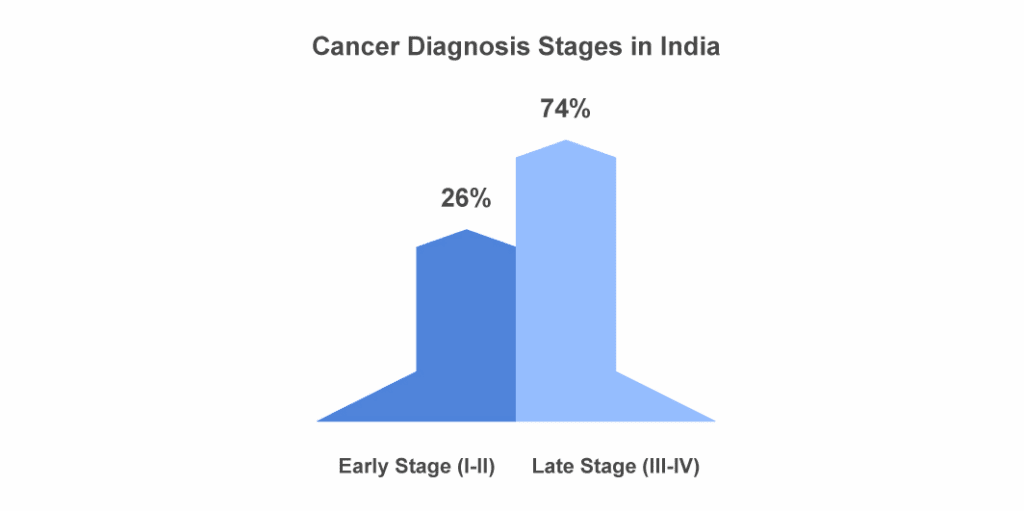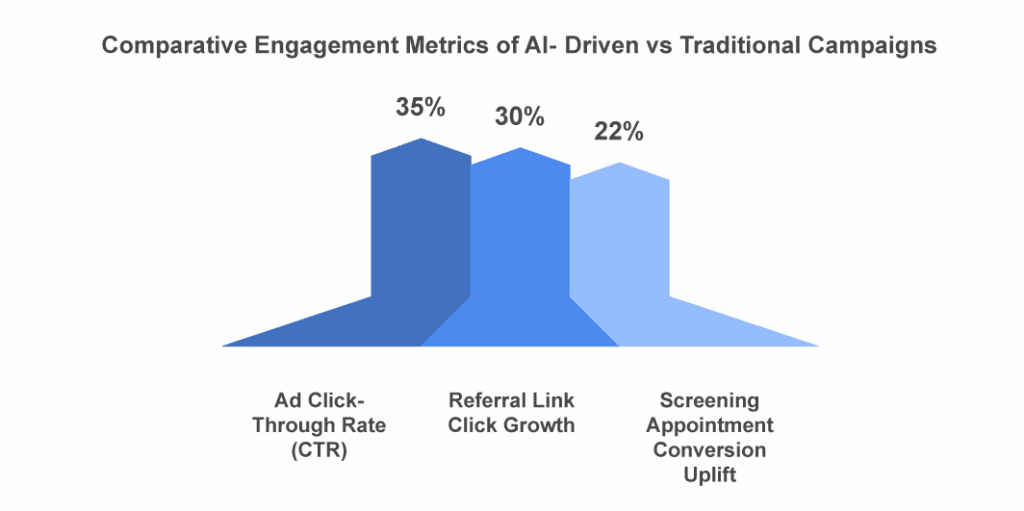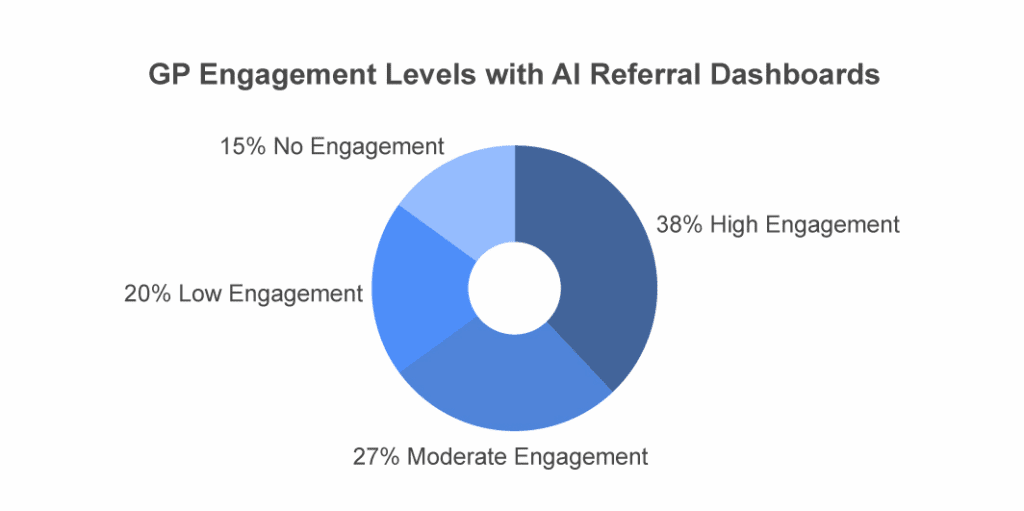Introduction: The Turning Point in Oncology Pharma Marketing
For decades, pharmaceutical marketing in oncology in India has centered on promoting treatment options and therapies. Historically, campaigns targeted oncologists with product brochures, CME invitations, and clinical trial updates. However, with cancer incidence rising and diagnosis timelines still lagging, the pharmaceutical industry is facing a new challenge, and a moral imperative.
In India, between 70 and 75 percent of cancer cases are still detected at an advanced stage (Stage III or IV). Late detection reduces survival rates, increases treatment costs, and burdens families emotionally and financially. The new question pharma marketers must ask is not just “How do we sell treatments?” but “How do we help detect cancer earlier?”
Artificial Intelligence (AI) is emerging as a transformational tool in this journey, enabling pharma companies to deploy hyper-targeted, predictive, and personalized campaigns that nudge both healthcare professionals (HCPs) and patients toward early diagnosis and timely referrals.
This article explores how oncology pharma marketing can evolve, combining AI-driven insights, digital outreach, behavioral nudging, and real-time analytics to influence diagnostic timelines across India.
Section 1: Understanding the Early Diagnosis Gap in Oncology
Despite significant investments in oncology infrastructure across India, the country continues to grapple with late-stage cancer diagnoses. Early detection remains a critical gap in the cancer care continuum.
Key Barriers to Early Diagnosis:
- Low Awareness among Primary Care Physicians (PCPs):
Many general practitioners (GPs), especially in rural and semi-urban areas, lack specialized training in identifying early warning signs of cancer. This often leads to delayed referrals to oncologists. - Limited Diagnostic Infrastructure:
Tier 2 and Tier 3 cities face an acute shortage of advanced screening facilities such as mammography, low-dose CT scans, and biopsy services, forcing patients to travel long distances for basic tests. - Socio-Cultural Stigma and Fear:
A large section of the population associates cancer with inevitable mortality, leading to fear-driven denial and reluctance toward early screening. - Fragmented Referral Pathways:
Even when symptoms are recognized, there’s no streamlined system for patient referral, causing further diagnostic delays.
Data Snapshot: India’s Cancer Diagnosis Stages
According to the Indian Council of Medical Research (ICMR) and WHO-SEARO:
- Only 26% of all cancer cases in India are detected at an early stage (Stage I or II).
· A startling 74% receive a diagnosis in Stage III or IV, which is an advanced stage.

The Opportunity for Pharma Marketers:
Pharmaceutical companies with an emphasis on oncology are uniquely positioned to fill this diagnostic void. By leveraging AI-driven targeting, physician education tools, regional outreach programs, and patient-facing digital interventions, pharma marketers can play a crucial role in shifting the diagnostic curve toward earlier detection, eventually strengthening brand confidence in the healthcare industry and increasing patient outcomes.
Section 2: AI in Oncology Marketing; Beyond Buzzwords
Artificial Intelligence is often discussed in the context of drug discovery or clinical decision support. But in pharma marketing, especially in oncology, AI is now influencing:
a) Predictive HCP Targeting:
AI tools can analyze thousands of data points, prescription patterns, conference attendance, CME participation, digital behavior, to identify general physicians (GPs) and specialists with the most potential to influence early cancer diagnosis.
b) Behavioral Segmentation:
By mining digital footprints (website visits, email clicks, webinar participation), AI algorithms can classify HCPs as:
- Active Referrers
- Potential Influencers
- Non-engaged segments
This allows marketers to tailor their messaging and frequency accordingly.
c) Patient Geo-Mapping:
AI-driven geospatial analysis can identify cancer hot-spots or low-screening zones. Pharma marketers can then hyper-localize their awareness campaigns.
Section 3: AI-Powered HCP Engagement Models
1. AI Chatbots for Clinical Decision Support:
Pharma brands can deploy AI chatbots that help GPs quickly assess cancer risk based on patient symptoms. These bots can:
- Guide through symptom checklists
- Suggest diagnostic tests
- Provide referral contact details for nearby oncologists
2. Email Personalization at Scale:
Using Natural Language Processing (NLP), pharma marketers can send tailored email content that matches each doctor’s specialty, location, and referral behavior.
3. CME Content Recommendation Engines:
AI can recommend CME modules to HCPs based on their past learning behavior. Example:
- A GP who recently attended a session on lung health gets nudged toward a lung cancer early signs module.
Outcome Expected:
Higher engagement and knowledge retention among primary care physicians, leading to faster patient referrals.
Section 4: AI-Driven Public Awareness Campaigns; Reaching Patients Before It’s Too Late
While engaging healthcare professionals (HCPs) is essential for improving cancer referral rates, public awareness plays an equally critical role in driving early diagnosis. The rise of AI-driven digital marketing tools has transformed how pharmaceutical brands can target, engage, and influence patient behavior across India.
AI Use Cases in Oncology Patient Campaigns:
- Predictive Audience Targeting:
AI tools analyze regional digital behaviors, such as spikes in Google searches for terms like “breast lump symptoms” or “persistent cough”. These insights allow pharma marketers to deploy hyper-targeted digital ads in areas where public awareness is low but online interest signals growing concern. - Personalized Content Distribution:
AI algorithms monitor user search patterns and social media engagement to deliver content tailored to each individual’s needs.
For example:
- Users browsing for smoking cessation resources may be shown lung cancer awareness videos.
- Women exploring women’s health topics may receive targeted messaging about breast or cervical cancer screening.
- AI Chatbots for Patient Pre-Screening:
Chatbots provide an interactive self-assessment platform, helping users evaluate their cancer risk based on symptoms. The bot can then guide them to nearby screening centers or oncology specialists.
Campaign Performance Metrics:
AI-driven public awareness campaigns have consistently outperformed traditional digital campaigns in engagement and conversion metrics.

By combining predictive analytics, personalized content delivery, and real-time patient engagement via chatbots, pharma marketers can drive earlier patient action, increasing screening rates and supporting India’s fight against late-stage cancer diagnoses.
Section 5: Geo-Targeted and Regional Language AI Campaigns
Reaching India’s Linguistic and Regional Diversity:
AI-powered language models now allow oncology campaigns to be:
- Auto-translated and culturally localized for regional dialects
- Contextually optimized for better comprehension and engagement
Tactics:
- Dynamic Creative Optimization (DCO): Where AI auto-generates ad copies in 7-8 regional languages based on user location and browsing history.
- Sentiment Analysis: AI tools track user reactions (likes, comments, shares) and adjust messaging tone for future ads.
Result:
A recent cervical cancer awareness pilot across Maharashtra and West Bengal, using AI-powered regional targeting, reported:
- 40% higher video view time
- 2.5X higher engagement on WhatsApp outreach
Section 6: AI in Referral Pathway Management – Closing the Loop in Early Cancer Diagnosis
A critical yet often overlooked barrier in India’s oncology care continuum is the referral gap between primary care physicians (PCPs) and oncologists. Even when early symptoms are identified, inconsistent referral practices and patient drop-offs delay timely diagnosis. This is where AI-powered referral management systems are making a measurable difference.
Intelligent Referral Management Dashboards:
Pharma companies are now offering AI-driven dashboards to both general practitioners (GPs) and oncologists, enabling them to:
- Track referral volumes: Monitor the number of suspected cancer cases referred over a specific timeframe.
- Visualize referral trends: Heatmaps highlight referral hotspots and low-performing regions.
- Flag pending actions: Identify patients who haven’t followed up for diagnostic testing and recommend outreach measures.
These dashboards help HCPs stay accountable and proactive in managing potential cancer cases.
AI-Powered Auto-Nudge Systems for Doctors:
Using AI-based rule engines, these systems send personalized reminders to physicians.
Key Features:
- Doctors who haven’t referred any suspected cases within a pre-defined period receive automated, non-intrusive nudges.
- HCPs managing patient pools with high-risk profiles (e.g., smokers, elderly, or those with chronic coughs) receive customized prompts for cancer screening discussions.
Engagement Data Snapshot:
A recent multi-city pilot involving 1,200 GPs revealed the following engagement levels with AI referral dashboards:

AI-powered referral tools are not just improving process efficiency but actively driving earlier diagnostic action. By keeping GPs engaged and informed, pharma marketers can play a pivotal role in shortening India’s oncology referral timeline, leading to better patient outcomes.
Section 7: AI-Enhanced Content Formats for Oncology Awareness
1. Video Personalization:
AI tools now allow pharma brands to create personalized explainer videos where the patient’s name, location, and risk factors are dynamically inserted.
2. Interactive Symptom Checkers:
AI-driven web tools or mobile apps where users input their symptoms and get tailored next-step recommendations (doctor visit, screening test, etc.).
3. Voice-Activated Awareness Tools:
AI voice assistants (Alexa skills, Google Assistant actions) can guide users through cancer symptom FAQs in vernacular languages.
Case Example:
A breast cancer awareness campaign using AI-generated personalized WhatsApp videos saw:
- 55% video completion rate
- 28% increase in screening center inquiries
Section 8: Data Privacy and Ethical AI Usage
As pharma marketers use AI to handle patient data, ethical boundaries must be respected.
Principles to Follow:
- Explicit Consent: All patient interactions involving data capture must include opt-ins.
- Data Minimization: Only the most important information should be gathered.
- Transparency: Users should know how their data will be used.
- Bias Avoidance: AI models must be periodically audited to prevent discrimination based on gender, geography, or socio-economic status.
Pharma marketers must work closely with compliance and legal teams to ensure that AI tools meet GDPR and India’s upcoming Digital Personal Data Protection Act (DPDP Act) requirements.
Section 9: Measuring Impact: AI-Powered Analytics
Modern pharma marketing isn’t just about campaign launch, it’s about continuous optimization.
Key AI-Driven Metrics:
- Predictive Engagement Scores: AI predicts which HCPs are likely to refer soon and prioritizes them for outreach.
- Real-Time Dashboarding: Live dashboards showing campaign performance across channels (WhatsApp, Email, Social Media).
- Content Heatmapping: AI tools track which sections of a webinar or video receive the most attention (pause, rewind, replay).
Example Result Metrics from a Pan-India Pilot:
- Referral Rate Growth: 32% increase in lung cancer referrals over 3 months.
- HCP Engagement: 48% open rate on AI-personalized email campaigns.
- Patient Screening Uptake: 24% increase in mammography bookings in Tier 3 towns.
Section 10: AI-Powered Collaborative Campaigns: Pharma, NGOs & Government
AI-driven oncology campaigns work best when pharma brands partner with non-profit organizations and government health bodies.
Recent Successful Collaborations:
- AI-based Screening Tools in Public Health Centers: Pharma-sponsored AI diagnostic apps deployed across 300+ PHCs in UP and Bihar for oral cancer risk assessment.
- NGO-Led Virtual Tumor Boards: Supported by pharma AI platforms, where GPs can submit patient cases and get specialist inputs within 24 hours.
Government Partnership Opportunities:
- Integration with Ayushman Bharat Health and Wellness Centers
- Co-created awareness modules under National Cancer Control Program
AI can help optimize resource deployment by identifying high-risk districts, tracking outreach gaps, and adjusting campaign intensity.
Section 11: The Road Ahead: AI in Oncology Marketing – 2025 and Beyond
AI in oncology pharma marketing in India is still evolving, but its impact is becoming undeniable.
Emerging Trends:
- Predictive Patient Outreach: AI tools that forecast who is at higher risk based on demographic and behavioral data.
- Voice AI for Rural Campaigns: Using IVR and voice-based assistants for awareness in low-literacy populations.
- AI-Driven Social Listening: Tracking cancer-related online discussions to shape campaign messaging.
- Micro-targeted Referral Incentives: AI identifies underperforming districts and triggers additional HCP engagement incentives.
Conclusion: Purpose-Led, AI-Enabled Oncology Pharma Marketing
The oncology marketing playbook is no longer limited to drug promotion. Today, pharma companies in India are called to play an active role in shaping cancer care pathways, from early suspicion to confirmed diagnosis.
AI doesn’t just make this possible, it makes it scalable, measurable, and deeply personalized.
Pharma marketers must embrace this shift, designing campaigns that:
- Leverage AI ethically
- Drive both public and HCP behavior change
- Align with India’s cancer control goals
- Focus on saving lives as much as building brands
The oncology marketing leader of tomorrow is not just a content creator or a sales strategist. They are a data-driven healthcare advocate, using AI-powered insights to help India detect cancer earlier, refer patients faster, and ultimately improve outcomes at scale.
The Oncodoc team is a group of passionate healthcare and marketing professionals dedicated to delivering accurate, engaging, and impactful content. With expertise across medical research, digital strategy, and clinical communication, the team focuses on empowering healthcare professionals and patients alike. Through evidence-based insights and innovative storytelling, Hidoc aims to bridge the gap between medicine and digital engagement, promoting wellness and informed decision-making.



